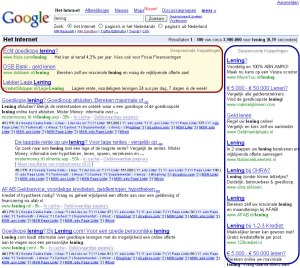Yet another excellent workshop today by Lucidica founder and Chief Technology Officer (CTO) Thomas Jeffs. This time exploring the world of Google AdWords and Pay-Per-Click Advertising. I have known a bit about these for a while now, in particular their importance to website promotion. But, couldn’t face the effort of getting stuck in on my own. Now I feel I have a really good understanding. Here are my notes from the workshop:
Google and every other search engine makes their money through advertising.
You can spend time working your way up the ‘natural’ search results, or short-cut your way to the to the top by paying via AdWords.
Tom warned that we should not ignore Yahoo and Bing, but also be aware that Google dominates search with over 80% of the market.
The first and most important job is to choose keywords you want associated with your site and decide on your budget. Once your daily budget has gone (pay per click), your advert disappears. Known as pay per action model.
Almost the entire source of Google’s advertising income is pay per click.
Costs are calculated dynamically based on a bidding auction system. You set your maximum bid. You can tell how popular search terms are by how many appear under sponsored section after a Google search.
It’s like bidding on a wardrobe in an auction – the maximum you may be willing to pay could be £1,000, but if no one bids above £600, you’ll get the wardrobe for £605. The difference here is that you have to tell the auctioneer upfront.
Pay per Click Statistics
A combination of marketing and statistics skills required, so you may need to get help with one or the other.
There are eight key metrics:
- Impressions – simply how many times your advert appears (not how many times the adword term was searched for).
- Clicks – how many times someone clicked on your link (compare to impressions above).
- Click Through Rate (CTR) – clicks divided by impressions
- Average Position – Position your advert appears when it is clicked on. Includes pages one and two.
- Maximum Cost per Click – directly impacts your position on results page and the number of clicks you get. Google help you find out how much you could expect to pay.
- Average Cost per Click – depends on what you competitors are bidding.
- Cost per Thousand (CPM) – the cost you are paying on your advert per 1,000 impressions (not clicks).
- Advert Quality – Marked out of 10. A woolly metric that Google measures on:
- Advert relevance – your keywords, and to the landing page on your site
- Historical performance – of the ad and your account overall
- Other relevant factors – basically anything Google wants
Getting more complicated
Google try to make things easier for you, but this can have negative consequences
Matching
- Phrase matching – examples
- Broad matching – examples
- Broad matching is the default setting within an AdWords campaign
- Can go badly wrong – Mulesource example – AdWords account records from Mulesource, the San Francisco-based open source outfit that has spent close to $90,000 on the ad system since November 2006, show the unpredictability of broad matches. When the company bids on a word like “mule,” Google may broad match on “muele,” “mula,” “mula spain,” “mulapelada,” “riding mules for sale,” “trainer mules,” and “yamaha mules.” And the list goes on. Google’s riches rely on ads, algorithms, and worldwide confusion
Content Network
- Where your ads are displayed on other websites:
- GoogleMail
- National Newspapers
- Your competitors
- Anyone operating Adscence
Google will try to match the content of the ad (or keywords) with the content of the page.
CTR and CPC is usually much lower than standard Google
The default setting for the content network is on.
Can go badly wrong – example of Air France crash and Virgin ad
Matching and Content Network
- Sometimes they work – i.e. get a higher return on investment
- Sometimes the don’t – they cause a lower Ad Quality so lower return on investment
Ad Quality
- Score given by Google out of 10 – high good, low bad
- Check monthly at the least
Calculation:
- The historical Click Through Rate of the keyword and the matched ad on Google
- Your account history, measured by the CTR of all the ads and keywords in your account
- The historical CTR for he Display URLs in the ad group
- The quality of your landing page (target URL)
- The relevance of the keyword to the ads in its ad group
- The relevance of the keywords and the matched ad to the search query
- Your account’s performance in the geographical region where the ad will be shown
- Other relevance factors
What your Ad Quality impacts:
- The lower the Ad Quality, the higher your Cost per Click will be
- Ad Rank = Max. CPC x Quality Score
- Actual CPC = (Ad Rank to beat divided by Quality Score) + $0.01
- So if you have a low Ad Quality you can be paying up to 10 times your nearest competitor and still appear below them on a search result.
- Affects your Ad position
- Your Cost per Click
- And in some cases… whether your ad appears at all
- Low Ad Quality needs to be addressed or the ad removed before it damages the rest of your accounts
Measuring your return on investment
Define your goals
- Should be the first thing you do with PPC
- Good Goals
- Visitor completing a sale
- Visitor requesting further information
- Visitor reaching the ‘contact us’ page
- Bad Goals
- I want to increase profit by more than spend
- Ugly Goals
- I want to increase traffic to my website
Measuring
- record your traffic – if you haven’t got a good website statistics package keep your spend low until you do
- Google Analytics is very good for trends and integration with AdWords
- You can define pages as goals and then display AdWords campaigns within you Analytics account.
- It will show you not just ‘conversions’, but also how your campaign performs against the rest of the site traffic.
- Stats packages can track your customers entire route through your website
- Especially whether they bought or left
- Define your goals as completions:
- Order confirmation pages – not ‘buy buttons’
- Thanks for your request, not ‘contact us’ forms
- Track all conversions, you will need to set up different ones for AdWords traffic:
- Phone numbers
- Email addresses
- Contact forms
- You need to measure the exact results for your £100 spend on AdWords
- Website visitors mean nothing if they don’t buy anything, or fill in a form.
- Look very closely at:
- Conversions
- Bounce rate (single visit and off)
- Average time on site
- Average number of pages visited
- Whether they are a new visitor (don’t pay for someone who’ll buy from you anyway)
Experiment with changes to AdWords and website, do one at a time so you can measure the difference.
Improving your return on investment
- Pick your keywords and or phrases
- Very important
- Need to think out of the box – not how would I search for my site or service, but how would my customers
- You can control the matching by:
- Keyword = broad matching – e.g. pet is extended to animal
- “keyword” = match exact phrase
- [keyword] = match exact term only
- –keyword = don’t match this term
- Remember that ‘mistakes’ affect your Ad Quality that can increase your CPC across all campaigns.
Design your advert
- Minor tweaks can effect your click through rate
- Changes to title, description or both
- 25 characters for title
- 70 characters for description
Decide when to run your advert
- think about what time is best to run ad
- business hours, weekends, morning, afternoon
- stagger throughout the day to spread your budget
Decide where it runs
- choose geographic location of ad
- country targeting works accurately
- regional is less accurate
- choose to run on content network – or not
- suggest running two campaigns – one on the content network and one off – compare the results
- websites share with Google
- age details of users
- sex details
- income details
- geographic location
- so you can choose to target specific demographics
- you can run exclusions such as ‘conflict and tragedy’
- target specific websites such as:
- Live.com
- Yahoo
- Googlemail
- Specify ‘below the fold’ or not, so the ad only appears when the viewer doesn’t have to scroll to view it.
- Specify ‘frequency to particular viewers’, so they only see it x number of times.
Decide where it goes – the landing page
- specify which page the advert clicks through to – not always your home page
- create pages to match ad campaigns
- create several landing pages to test the effect on:
- bounce rate
- Ad Quality
- Conversion rate
Top 5 things to change:
- Content network on or off – need to experiment with both
- Different keywords
- Different adverts
- Different landing pages
- Different time of day
Be wary of statistics – need at least 100 clicks to see if something works or not
Assumptions
- Start off you campaigns with what you think, but never assume
- e.g. B2B only search during business hours
- Operating outside the norm can yield great results, and cost you much less.
6 tips to better Ad Quality
N.B Ad Quality is the golden goose of PPC, master it and the rest of PPC is easy. It is though a dark art with many variables.
- Maximise ad relevance – try to match ‘search phrase’
- Maximise landing page relevance
- Know your search phrase – e.g. victim support London vs it support London – Importance of matching your AdWords or phrases to your audience – e.g. Librarians will be likely to be using Boolean search terms, others are unlikely to do so.
- Split test and delete the poor performers
- Have good ‘on page’ SEO – especially relevant to ad copy
- Undertake good practice – check web standards – Google likes sites that do this
- You can’t always understand why results are poor
- But you can stop running ads that don’t work
- Ignoring bad performance will lead to a vicious cycle where your ad quality goes down and your CPC goes up
- Mastering PPC is just simply about watching the numbers and understanding what they mean:
- Increasing the budget on the good – 8’s and above
- Decreasing the budget on the bad – between 5 and 8
- Stopping the budget on the ugly – below 5
Tips on outsourcing AdWords to others:
- Start small and see what they can achieve initially
- Check for conflicts of interest with rival clients
- Check to make sure they don’t use ‘spamming’ techniques which could damage your reputation with Google.




 I recently required the services of a local locksmith, as I was finding it increasingly difficult to unlock my back door.
I recently required the services of a local locksmith, as I was finding it increasingly difficult to unlock my back door.
 I was rather surprised to see the latest
I was rather surprised to see the latest 




 I am glad to report that the evening lived up to its billing, with an excellent crowd, some learnings from our speaker Heather Gorringe of
I am glad to report that the evening lived up to its billing, with an excellent crowd, some learnings from our speaker Heather Gorringe of